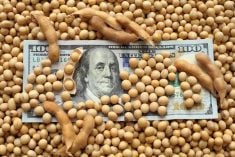MarketsFarm — As March 1 marked the start of meteorological spring, it feels like anything but that in southern Manitoba.
One of the snowiest and coldest winters in years has been a mixed blessing for pulse growers, providing much-needed moisture for fields while also raising flood fears in some areas.
Dennis Lange, a pulse specialist for the Manitoba government at Altona, believes growers will have to wait before they can start seeding.
“I don’t think there’s going to be an early seeding. There’s not going to be one of those mid-April seedings unless something dramatic happens. I think it will be towards the end of April, beginning of May before we get into the fields,” he said.
Read Also

U.S. grains: Soybeans retreat after rally, wheat holds at three-month high
U.S. soybean futures fell on Tuesday, retreating from a 16-month high hit a day earlier, as traders awaited Chinese purchases of U.S. cargoes following last week’s trade truce agreed by the world’s two largest economies.
Pulse growers in the Red River Valley are keeping a close eye on the potential for flooding due to the relatively large snow pack.
“There have been some concerns…but time will tell,” Lange added.
Prices for pulses are still higher than last year. In the case of Manitoba dry beans, they have ranged from steady to 21.5 cents higher than in 2021. However, due to rising prices for other commodities, it will be hard for pulses to gain seeded acres in 2022.
“Last year, we had about 175,000 acres (of dry beans) planted (in Manitoba) in 2021. It’s been a little slow-going. I would expect that we might see a slight drop in acres, around (150,000),” said Lange. “I don’t think we’re going to see any big swings in either direction.”
He also estimates 1.2 million acres of soybeans to be planted this year in Manitoba, similar to last year. As for peas, Lange believes the planted area will be equal to or slightly less than the 2021 figure of 277,000 acres.
“What may swing things a little bit more for pulses may be the high nitrogen prices,” he said. “If growers are looking to grow pulses, they won’t be adding any additional nitrogen for peas and for soybeans. In those situations, they may grow a few more acres but they also have to keep their crop rotations in line.”
However, the biggest determinant for whether there will be any semblance of a normal pulse crop or not in 2022 is the amount of moisture in the soil after the devastating drought of the previous two years.
“Having timely rainfalls throughout the growing season makes a huge difference,” he said. “Everything else being equal, timely rainfalls would be a big help for most of the crops in Manitoba.”
— Adam Peleshaty reports for MarketsFarm from Stonewall, Man.













